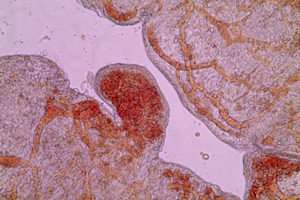Placenta's oxygen tanks for early embryos revealed

A new role for the placenta has been revealed by University of Manchester scientists who have identified sites which store, and gradually release, oxygen for newly formed embryos in the weeks after the baby's heart is developed.
The new research reveals how the early placenta solves the problem of supplying oxygen to the growing embryo in the second and third months of pregnancy, as it gradually takes over this role from the yolk sac.
The scientists show that as the placenta grows in the first few weeks, small groups of stem cells are formed from which primitive red blood cells arise. These cells are able to gather up and store oxygen under the unusually low concentrations found at the implantation site.
Blood vessels gradually grow towards these cell groups, leading to the slow release of oxygen-laden red cells to the embryo and keeping it supplied until more efficient oxygen transfer becomes possible as maternal blood enters the placenta at the end of the third month.
Professor John Aplin, from the University's Institute of Human Development, led the study. He said: "Early embryos are completely dependent on the mother for the supply of oxygen, and to identify the way in which it is taken up and distributed is important for understanding more about these early stages of life.
"The human placenta has evolved a unique and elegant solution to this problem, in which the process of supplying oxygen is intimately connected with growth of the placenta itself."
It had been believed that the yolk sac contributed the bulk of oxygen at this stage but recent studies have shown that this gradually decreases in importance as the embryo ages. The heart begins beating at around four weeks but oxygen is still supplied by the mother.
The new research, published in the journal Placenta has shown how a complex network of cells develops in the placenta to extract this oxygen and supply it to the embryo. They also found new levels of detail in the structures that link the blood supplies between placenta and embryo.
The advance was made possible by new techniques for studying samples, which were sourced from tissue banks for this study.
Professor Aplin said: "The work has been made possible by new approaches to imaging placental tissue which means that greater levels of cellular diversity and detail can be revealed.
"We're now uncovering more and more information which gives us a better insight into earlier stages of pregnancy than ever before."
The paper, 'Hemangioblastic foci in human first trimester placenta: distribution and gestational profile', was published in the journal Placenta.
More information: "Hemangioblastic foci in human first trimester placenta: Distribution and gestational profile," Placenta, Available online 11 August 2015, ISSN 0143-4004, dx.doi.org/10.1016/j.placenta.2015.08.005

















